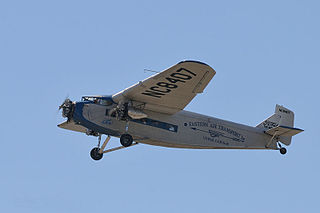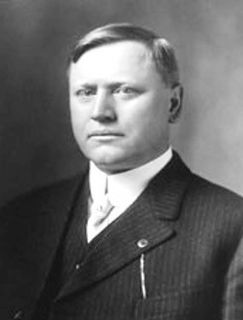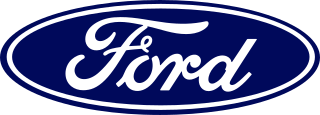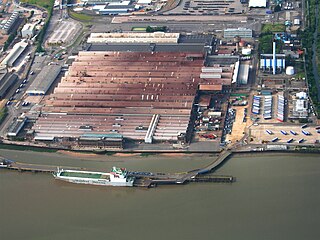
An assembly line is a manufacturing process in which parts are added as the semi-finished assembly moves from workstation to workstation where the parts are added in sequence until the final assembly is produced. By mechanically moving the parts to the assembly work and moving the semi-finished assembly from work station to work station, a finished product can be assembled faster and with less labor than by having workers carry parts to a stationary piece for assembly.
Burmeister & Wain was a large established Danish shipyard and leading diesel engine producer headquartered in Copenhagen, Denmark. Founded by two Danes and an Englishman, its earliest roots stretch back to 1846. Over its 150-year history, it grew successfully into a strong company through the end of the 1960s. In the 1970s, global competitive pressures, particularly from the far east, began to take their toll. In 1980, B&W became MAN B&W Diesel A/S, part of MAN B&W Diesel Group, a subsidiary of the German corporation MAN AG, with operations worldwide. The company still maintains operations at three main sites in Denmark for manufacturing, servicing, and licensing of its two-stroke engines and complete propulsion systems.

The Ford Model T is an automobile produced by Ford Motor Company from October 1, 1908, to May 26, 1927. It is generally regarded as the first affordable automobile, which made car travel available to middle-class Americans. The relatively low price was partly the result of Ford's efficient fabrication, including assembly line production instead of individual handcrafting.

Studebaker was an American wagon and automobile manufacturer based in South Bend, Indiana. Founded in 1852 and incorporated in 1868 as the Studebaker Brothers Manufacturing Company, the firm was originally a coachbuilder, manufacturing wagons, buggies, carriages and harnesses.

The Henry Ford Company was an automobile manufacturer active from 1901 to 1902. Named for Henry Ford, it was his second company after the Detroit Automobile Company, which had been founded in 1899. The Henry Ford Company was founded November 1901 from the reorganization of the Detroit Automobile Company. The company, much like the Detroit Automobile Company, was plagued by disputes between Ford and his investors, and Ford left in 1902. Later that year, the company was reorganized as the Cadillac Automobile Company under the suggestion of Henry M. Leland. Cadillac, whose early vehicles were identical in design to those of Ford's later Ford Motor Company except for the engine, would develop a reputation for precision engineering and was acquired by the nascent General Motors (GM) in 1909, becoming GM's luxury marque. Ford would eventually find success with the Ford Motor Company, and is considered one of the primary pioneers of the automobile.

The Ford Trimotor is an American three-engined transport aircraft. Production started in 1925 by the companies of Henry Ford and ended on June 7, 1933. A total of 199 Ford Trimotors were made. It was designed for the civil aviation market, but also saw service with military units.

The Highland Park Ford Plant is a former Ford Motor Company factory located at 91 Manchester Avenue in Highland Park, Michigan. It was the second American production facility for the Model T automobile and the first factory in history to assemble cars on a moving assembly line. It became a National Historic Landmark in 1978.

Fordson was a brand name of tractors and trucks. It was used on a range of mass-produced general-purpose tractors manufactured by Henry Ford & Son Inc from 1917 to 1920, by Ford Motor Company (U.S.) and Ford Motor Company Ltd (U.K.) from 1920 to 1928, and by Ford Motor Company Ltd (U.K.) from 1929 to 1964. The latter also later built trucks and vans under the Fordson brand.
Charles Emil Sorensen was a Danish-American principal of the Ford Motor Company during its first four decades. Like most other managers at Ford at the time, he did not have an official job title, but he served functionally as a patternmaker, foundry engineer, mechanical engineer, industrial engineer, production manager, and executive in charge of all production.

John Francis Dodge was an American automobile manufacturing pioneer and co-founder of Dodge Brothers Company.

Horace Elgin Dodge Sr. was an American automobile manufacturing pioneer and co-founder of Dodge Brothers Company.
Mack Avenue Engine Complex is a 110-acre (45 ha) Chrysler automobile factory in Detroit, Michigan.
Windsor Casting Plant was an iron foundry owned by Ford Motor Company in Windsor, Ontario, Canada. The plant opened November 9, 1934 and was located next to the Windsor Engine Plant in downtown Windsor. It was known to area residents as "the foundry". Internally, it was called WCP.

Ford-Werke GmbH is a German car manufacturer headquartered in Niehl, Cologne, North Rhine-Westphalia and a subsidiary of Ford of Europe, which in turn is a subsidiary of Ford Motor Company. The company operates two large manufacturing facilities in Germany, a plant in Cologne and a plant in Saarlouis.

The Mason Machine Works was a machinery manufacturing company located in Taunton, Massachusetts, between 1845 and 1944. The company became famous for an early invention by its creator, William Mason, the self-acting mule, first patented in 1840. The company also later produced locomotives, rifles during the American Civil War, and later printing presses. However, the production of textile machinery would remain the company's core business during the late 19th century, until its decline in the 1920s.

Ford Dagenham is a major automotive factory located in Dagenham, London, operated by the Ford of Britain subsidiary of Ford Motor Company. The plant opened in 1931 and has produced 10,980,368 cars and more than 39,000,000 engines in its history. It covers around 475 acres and has received over £800 million of capital investment since 2000.

LeBaron Incorporated was an American design business from 1920 and also a coachbuilder from 1924 until 1953.

Henry Ford's Village Industries were small factories located in rural areas of Michigan. Ford developed his Village Industries in part to provide farm workers a stable source of income during the winter months.

The Red Cross stove is a kitchen or parlor stove used for cooking and heating mainly North American homes of the late 19th and early 20th century. The reason for the name "Red Cross" was because of the advertising logo, which featured a red Gothic cross.

William Roberts and Company of Phoenix Foundry in Nelson, Lancashire, England, produced many of the steam engines that powered cotton weaving and spinning mills of Pendle and neighbouring districts. Industrial historian Mike Rothwell has called Phoenix foundry “Nelson’s most significant engineering site”.















